The Darina Allen Column
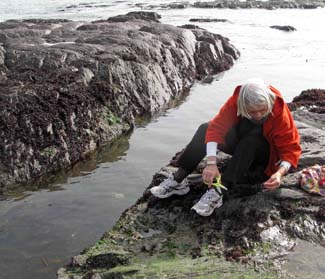 I recently spent a fantastic afternoon foraging in the rock pools on Ballyandreen strand close to Ballycotton in East Cork. It was one of a series of East Cork Slow Food Events to teach some Forgotten Skills, in this case how to identify and harvest edible seaweeds.
I recently spent a fantastic afternoon foraging in the rock pools on Ballyandreen strand close to Ballycotton in East Cork. It was one of a series of East Cork Slow Food Events to teach some Forgotten Skills, in this case how to identify and harvest edible seaweeds.
Bruce MacDonald was our guide; he has developed a business called Coppercoast Tours showing people how to collect food sustainably on the seashore. I myself am an enthusiastic forager and have been taking groups to local beaches for years, so I was really keen to learn more.
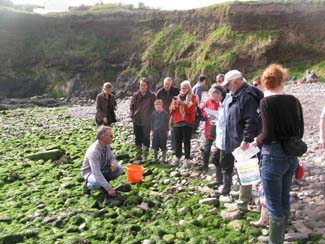 First Bruce gave us a pep talk about health and safety and sustainable harvesting. “Watch the tides and don’t turn your back on the sea while foraging. Move back to the shore in good time before the tide comes in. Keep your arms free to balance on the rocks and wear shoes with a good grip, Crocs are good because they are waterproof. Take a knife or a pair of scissors so you can cut (give it a trim not a shave) rather than yank the seaweed off the rocks.”
First Bruce gave us a pep talk about health and safety and sustainable harvesting. “Watch the tides and don’t turn your back on the sea while foraging. Move back to the shore in good time before the tide comes in. Keep your arms free to balance on the rocks and wear shoes with a good grip, Crocs are good because they are waterproof. Take a knife or a pair of scissors so you can cut (give it a trim not a shave) rather than yank the seaweed off the rocks.”
Over 600 seaweeds have been identified on our shores. Seaweed consist of three elements, the holdfast (the roots) the stipe (the stem) and the fronds (leaves). From the sustainability point of view, it’s really important to leave the holdfast attached to the rock so the seaweed can regenerate itself provided the cut is not too near the hold-fast.
I reckon I know a bit about foraging but I discovered so much more. Ballyandreen is a pebbly cove, sheltered by steep cliffs. There were lots and lots of slocán known as nori in Japan. It drapes itself over smooth rounded rocks, this is identical to laverbread which the Welsh love to eat with bacon or cockles.
Seaweed varies from one season to another. We found dillisk or dulse a little winey purple seaweed that grows along the crevices on the low rocks. When dried this has long been a favourite in Irish coastal communities.
There was lots of bright green sea lettuce in the little rock pools where my grandchildren love to paddle and catch tiny shrimps in the summer.
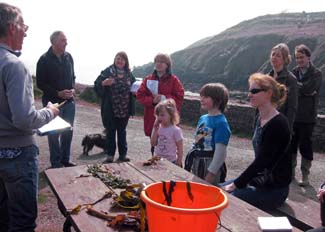 The tide was fully out, it was three days after a new moon and so the forest of carrageen on the little rocks was exposed so we could gather the moss easily. Traditionally carrageen was spread out on the spongey grass on the cliff tops to bleach in the sun and be washed by the rain.
The tide was fully out, it was three days after a new moon and so the forest of carrageen on the little rocks was exposed so we could gather the moss easily. Traditionally carrageen was spread out on the spongey grass on the cliff tops to bleach in the sun and be washed by the rain.
My mother-in law Myrtle Allen always got the carrageen moss for Ballymaloe House from Fred and Annie Dawes who harvested it year in year out in Ballyandreen. It took about 10 days to bleach and then it would keep for years. We all loved it and still do. Our babies and now our grandchildren are weaned onto carrageen moss pudding – a magic food full of iodine and trace elements.
Bruce also showed us several types of kelp with its long tough leaves - which is used to make Japanese Dashi - and five different types of bladder wrack, several are edible. A fellow forager told me that sheep on Ronaldsey live on a diet of bladder wrack and taste delicious.
Bruce was very excited to find some frilly alaria also known as wakame and an essential ingredient in Miso soup. There were also limpets, periwinkles and lots of tiny seed mussels attached to the rocks. We had lots of fun and a delicious supper from our afternoons foraging.
Contact Bruce MacDonald of Copper Coast Tours to find out the best spots for foraging for seaweed in your local area – +353 86 168 5328 – bruceinireland@gmail.com
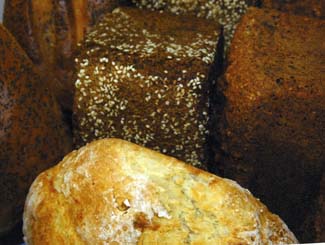 Dillisk Soda Bread
Dillisk Soda Bread
1 lb (450g) plain white flour, preferably unbleached
1oz (25g) of dilisk (dulse)
1 level teaspoon salt
1 level teaspoon (bicarbonate of soda/baking soda)
sour milk or buttermilk to mix - 12-14 fl.ozs (350-412ml) approx.
First fully preheat your oven to 230C/450F/regulo 8.
Sieve all the dry ingredients. Chop the dillisk (dulse) and add to the bowl.
Make a well in the centre. Pour all of the milk in at once. Using one hand, mix in the flour from the sides of the bowl. The dough should be softish, not too wet and sticky. When it all comes together, turn it out onto a floured board, knead lightly for a second, just enough to tidy it up.
Pat the dough into a round about (2.5cm) deep and cut a cross on it to let the fairies out! Let the cuts go over the sides of the bread to make sure of this.
Bake in the hot oven for 15 minutes, then turn the oven down to 200C/400F/regulo 6 for 30 minutes or until just cooked. If you are in doubt, tap the bottom of the bread: if it is cooked it will sound hollow.
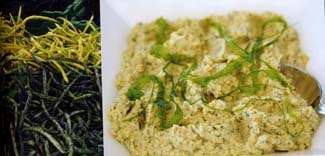 Prannie Rhatigan's Quick Seaweed Hummus
Prannie Rhatigan's Quick Seaweed Hummus
Bruce made a delicious butterbean and seaweed hummus from Prannie Rhatigan’s excellent book – The Irish Seaweed Kitchen.
seaweeds used: mixed seaweeds
serves 4
2 x 400g (14 oz) tins cannellini, chickpeas or butter beans,
or
450g (16 oz) cooked and drained
2-3 crushed garlic cloves
2 tablespoons tahini
4 tablespoons olive oil
juice of a lemon
1 heaped tablespoon mixed seaweeds, dried and ground in pestle and mortar
25g (1oz) chopped coriander leaves
½ teaspoon ground coriander seeds
2 tablespoons parsley chopped
1 teaspoon vegetable stock powder
¾ - 1 tsp Dijon mustard
Put all ingredients in food processor and blend to required texture. Refrigerate and drizzle with extra virgin olive oil. Garnish with lemon slices and parsley.
Top Tip - to dry seaweed, rinse well and drape it over a grill and place it on the back window of the car, in a hot press or in a very slow oven until dry.
Ivan Whelan’s Kelp and Smoked Seafood Salad
To serve 6-8
50g (20z) of dried kelp or wakame
150g (5oz) cold-smoked salmon
150g (5oz) smoked eel, weighed after skinning and boning
50g (2oz) pickled ginger (gari)
60g (2 ½oz) pine nuts
3tbsp soy sauce
3tbsp sesame oil
1½tbsp rice wine vinegar
Salt and freshly ground pepper
1tbsp freshly chopped coriander
30 smoked mussels
Soak the seaweed in cold water for about 30 minutes to reconstitute. Drain very well in a colander and press out all the excess water. Put into a large mixing bowl.
Cut the smoked salmon and eel into small pieces and chop the ginger. Add these to the seaweed, along with the pine nuts, soy sauce, sesame oil and rice wine vinegar, coriander and salt and pepper to taste.
Mix gently to avoid breaking up the fish. Serve stacked on a plate with smoked mussels dotted around.
Periwinkles with Homemade Lemon Mayonnaise
The world is made up of people who either take one periwinkle at a time or those who gather a little pile before they start eating – I belong to the first camp because I am too impatient to wait.
fresh live periwinkles
boiling salted water – 4 tablespoons to every 2.3 litres (4 pints) water
For the Lemon Mayonnaise
homemade Mayonnaise
zest and freshly squeezed juice of 1 organic lemon
To make the lemon mayonnaise, add the lemon zest to the basic mayonnaise recipe and substitute freshly squeezed lemon juice for the vinegar.
Bring the water to the boil, add the salt and the periwinkles, and then bring the water back to the boil. Cook for 3–4 minutes, strain off the water and allow the periwinkles to get cold. Serve with homemade lemon mayonnaise. Some people love to dip them in vinegar. Either way you will need to supply a large pin for each person to extract the winkles from the shells.
Chocolate Carrageen Moss Pudding
Serves 4-6
½ oz cleaned, well-dried carrageen moss (2 semi-closed fistfuls)
900ml (1 1⁄2 pints) whole milk
1 vanilla pod or 1⁄2 teaspoon pure vanilla extract
3 tablespoons cocoa
1 organic egg
2 tablespoons caster sugar
To Serve
soft brown sugar and softly whipped cream or a compote of fruit in season
Soak the carrageen in a little bowl of tepid water for 10 minutes. It will swell and increase in size. Strain off the water and put the carrageen into a saucepan with the milk and the vanilla pod, if using. Bring to the boil and simmer very gently, covered, for 20 minutes.
At that point and not before, separate the egg, put the yolk into a bowl, add the sugar and vanilla extract, if using, and whisk together for a few seconds, then pour the milk and carrageen moss through a strainer onto the egg yolk mixture, whisking all the time.
By now the carrageen remaining in the strainer will be swollen and exuding jelly. You need as much of this as possible through the strainer and whisk it into the egg and milk mixture.
Blend cocoa with a little of the milk and add to the hot strained carrageen. Test for a set in a saucer as one would with gelatine.
Whisk the egg white stiffly and fold or fluff it in gently; it will rise to make a fluffy top. Serve chilled with caster sugar and cream.
***
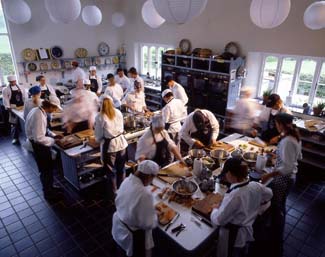 Once again this year, the Ballymaloe Cookery School in East Cork has a great program of cookery courses for all interests and abilities. Ranging from a relaxing visit to sit in on an afternoon cookery demonstration to a week long ‘Intensive Introductory Course’.
Once again this year, the Ballymaloe Cookery School in East Cork has a great program of cookery courses for all interests and abilities. Ranging from a relaxing visit to sit in on an afternoon cookery demonstration to a week long ‘Intensive Introductory Course’.
Sitting in the middle of a 100 acre organic farm the Ballymaloe Cookery School provides its students not only with a life skill learnt under the expert tutelage of their very capable teachers but also a place to relax and unwind from the stresses and strains of normal everyday life. The cottage accommodation available onsite consists of a collection of delightful converted outbuildings which have been transformed over the years by the Allens.
www.cookingisfun.ie





There are currently no comments
Leave a comment
Not a member? Register for your free membership now!
Or leave a comment by logging in with: